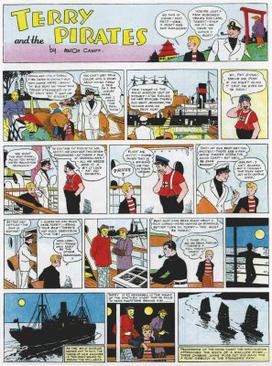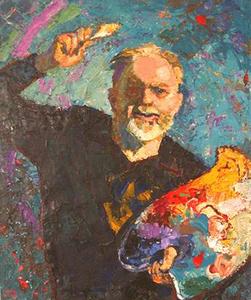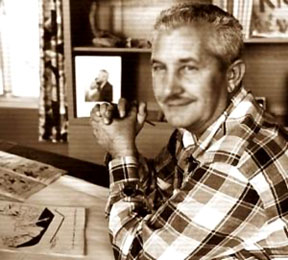
Terry and the Pirates is an action-adventure comic strip created by cartoonist Milton Caniff, which originally ran from October 22, 1934, to February 25, 1973. Captain Joseph Patterson, editor for the Chicago Tribune New York News Syndicate, had admired Caniff's work on the children's adventure strip Dickie Dare and hired him to create the new adventure strip, providing Caniff with the title and locale. The Dragon Lady leads the evil pirates; conflict with the pirates was diminished in priority when World War II started.

Milton Arthur Paul Caniff was an American cartoonist known for the Terry and the Pirates and Steve Canyon comic strips.

George S. Wunder was a cartoonist best known for his 26 years illustrating the Terry and the Pirates comic strip.

Noel Douglas Sickles was an American commercial illustrator and cartoonist, best known for the comic strip Scorchy Smith.

Scorchy Smith is an American adventure comic strip created by artist John Terry that ran from March 17, 1930 to December 30, 1961.
A daily strip is a newspaper comic strip format, appearing on weekdays, Monday through Saturday, as contrasted with a Sunday strip, which typically only appears on Sundays. They typically are smaller, 3–4 grids compared to the full page Sunday strip and are black and white.

Russell Patterson was an American cartoonist, illustrator and scenic designer. Patterson's art deco magazine illustrations helped develop and promote the idea of the 1920s and 1930s fashion style known as the flapper.
The Eastern Color Printing Company was a company that published comic books, beginning in 1933. At first, it was only newspaper comic strip reprints, but later on, original material was published. Eastern Color Printing was incorporated in 1928, and soon became successful by printing color newspaper sections for several New England and New York papers. Eastern is most notable for its production of Funnies on Parade and Famous Funnies, two publications that gave birth to the American comic book industry.

Dickie Dare was a comic strip syndicated by AP Newsfeatures. Launched July 31, 1933, it was the first comic strip created by Milton Caniff before he began Terry and the Pirates. The strip ended on October 12, 1957.

Tribune Content Agency (TCA) is a syndication company owned by Tribune Publishing. TCA had previously been known as the Chicago Tribune Syndicate, the Chicago Tribune New York News Syndicate (CTNYNS), Tribune Company Syndicate, and Tribune Media Services. TCA is headquartered in Chicago, and had offices in various American cities, the United Kingdom, the Netherlands, and Hong Kong.
A comic strip syndicate functions as an agent for cartoonists and comic strip creators, placing the cartoons and strips in as many newspapers as possible on behalf of the artist. A syndicate can annually receive thousands of submissions, from which only two or three might be selected for representation. In some cases, the work will be owned by the syndicate as opposed to the creator. The Guinness World Record for the world's most syndicated strip belongs to Jim Davis' Garfield, which at that point (2002) appeared in 2,570 newspapers, with 263 million readers worldwide.

Frederick Coulton Waugh was a cartoonist, painter, teacher and author, best known for his illustration work on the comic strip Dickie Dare and his book The Comics (1947), the first major study of the field.

The McNaught Syndicate was an American newspaper syndicate founded in 1922. It was established by Virgil Venice McNitt and Charles V. McAdam. Its best known contents were the columns by Will Rogers and O. O. McIntyre, the Dear Abby letters section and comic strips, including Joe Palooka and Heathcliff. It folded in September 1989.

James Robert Williams was a Canadian cartoonist who signed his work J. R. Williams. He was best known for his long-run daily syndicated panel Out Our Way. As noted by Coulton Waugh in his 1947 book The Comics, anecdotal evidence indicated that more Williams' cartoons were clipped and saved than were other newspaper comics. A newspaper promotion of 1930 compared him to poets Eugene Field and James Whitcomb Riley.

Richard William Dorgan was an American cartoonist, writer, and illustrator. His first known published work appeared in The New York Call in 1913. A wide variety of his early work was published in The Broadside: A Journal for the Naval Reserve Force, 1918–1920.

Oaky Doaks was an American newspaper comic strip, which ran between June 17, 1935, and December 30, 1961. It was distributed by AP Newsfeatures for more than 25 years, illustrated by veteran magazine cartoonist Ralph Fuller and scripted by AP Newsfeatures comics editor William McCleery.

Don Flowers (1908–1968) was an American cartoonist best known for his syndicated panel Glamor Girls. Flowers was noted for his fluid ink work, prompting Coulton Waugh to write that Flowers displayed "about the finest line ever bequeathed to a cartoonist. It dances; it snaps gracefully back and forth; the touches related."

Ralph Briggs Fuller was an American cartoonist best known for his long-running comic strip Oaky Doaks, featuring the humorous adventures of a good-hearted knight in the Middle Ages. He signed the strips R. B. Fuller.

Paul Fung (1897–1944) was an American cartoonist best known for the comic strip Dumb Dora.
The Central Press Association was American newspaper syndication company based in Cleveland, Ohio. It was in business from 1910 to 1971. Originally independent, it was a subsidiary of King Features Syndicate from 1930 onwards. At its peak, the Central Press supplied features, columns, comic strips, and photographs to more than 400 newspapers and 12 million daily readers. Notable comic strips that originated with Central Press include Brick Bradford, Etta Kett, and Muggs McGinnis.

















